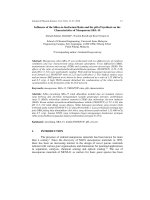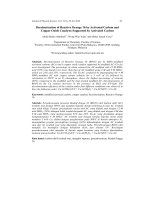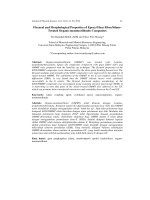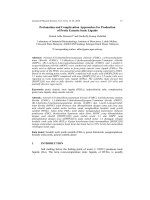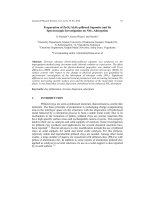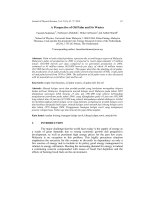Báo cáo vật lý: "Thermo-mechanical and Light Transmittance of Silica Diffusant Filled Epoxy Composites" docx
Bạn đang xem bản rút gọn của tài liệu. Xem và tải ngay bản đầy đủ của tài liệu tại đây (1.14 MB, 15 trang )
Journal of Physical Science, Vol. 21(1), 93–107, 2010 93
Thermo-mechanical and Light Transmittance of Silica
Diffusant Filled Epoxy Composites
Lim Wei Chin
1
, Huong Ling Hung
2
and Chow Wen Shyang
1*
1
School of Materials and Mineral Resources Engineering, Universiti Sains Malaysia,
Engineering Campus, 14300 Nibong Tebal, Pulau Pinang, Malaysia
2
Oriem Technology Sdn Bhd, Plot 25, Bayan Lepas Industrial Estate,
Non-FTZ, Phase 4, 11900 Bayan Lepas, Pulau Pinang, Malaysia
*Corresponding author:
Abstract: Epoxy ternary blends (DCN) were prepared by mixing diglycidyl ether
bisphenol A (DGEBA), cycloaliphatic epoxy, and novolac epoxy. The silica diffusants
were prepared by the addition of spherical silica (SS) into epoxy blends. The thermal
properties of the epoxy composites were characterised using a thermo-mechanical
analyser (TMA), a differential scanning calorimeter (DSC), and a dynamic mechanical
analyser (DMA). It was found that the storage modulus of the epoxy was increased in the
presence of SS diffusants. However, the coefficient of thermal expansion (CTE) and the
glass transition temperature (T
g
) of the epoxy ternary blends was reduced by the addition
of SS diffusants, which was because the expansion of the epoxy matrix was constrained in
the presence of silica fillers. The UV/Vis spectroscopy results demonstrated that the
percentage of transmittance of epoxy was decreased by the incorporation of the silica
diffusant.
Keywords: polymer composites, thermal properties, light-emitting diodes (LED), epoxy
blends, silica
Abstrak: Adunan ternari epoksi (DCN) disediakan dengan pencampuran diglicidil eter
bisfenol A (DGEBA), epoksi silkoalifatik, dan epoksi novolak. Difusan silika disediakan
dengan penambahan silika sfera (SS) ke dalam adunan epoksi. Sifat-sifat terma bagi
komposit epoksi dikaji dengan menggunakan penganalisis mekanik haba (TMA),
kalorimetri pengimbasan pembezaan (DSC), dan penganalisis mekanik dinamik (DMA).
Modulus simpanan bagi epoksi telah ditingkatkan dengan kehadiran difusan SS. Walau
bagaimanapun, pekali pengembangan haba (CTE) dan suhu peralihan kaca (T
g
) bagi
adunan ternari epoksi telah diturunkan dengan penambahan difusan SS disebabkan
pengembangan matriks epoksi telah dihalang dengan kehadiran pengisi silika.
Keputusan spektroskopi UV/Vis menunjukkan bahawa peratusan transmisi bagi epoksi
dikurangkan dengan penambahan difusan silika.
Kata kunci: komposit polimer, sifat-sifat terma, diod pemancar cahaya (LED), adunan
epoksi, silika
Silica Diffusant Filled Epoxy Composites 94
1. INTRODUCTION
Epoxy resins have become increasingly important because of the wide
variety of their applications in the automotive, aerospace, electronics, and plastics
industries, and because of their structural applications.
1
The typical
characteristics of epoxy are good chemical and corrosion resistance, good
mechanical and thermal properties, outstanding adhesion to various substrates,
low shrinkage upon curing, high flexibility, good electrical properties, and the
ability to be processed under a variety of conditions.
2
Epoxy is an important resin
in the light emitting diode (LED) industry because it has good thermal stability
and mechanical properties, and it is suitable for the encapsulation of silicon chips
and lead frames.
3
Light emitting diodes have replaced incandescent, fluorescent,
and neon lamps. The factors that make LEDs so common are due to their ability
to produce high luminosity at low currents and voltages and match with silicon-
integrated circuits. Besides, LEDs have low-power consumption, longer service
lives, and are able to be transformed into different shapes.
4
LED lamps are
encapsulated by transparent polymers such as epoxy resin with refractive indices
in the range of 1.5–1.6.
In the LED industry, the most common epoxy resins are diglycidyl ether
of bisphenol A (DGEBA) and cycloaliphatic epoxy resin (CAE). However,
DGEBA epoxy resin tends to undergo discoloration; on the other hand, CAE is a
brittle material.
5,6
Improvements have been done by many researchers to
overcome the weakness of DGEBA epoxy resins and CAE. To solve this
problem, DGEBA was blended with CAE to reduce the thermal discoloration.
The blending of DGEBA with CAE could enhance the polymerisation rate even
at low catalyst concentrations and, thus, subsequently reduce thermal
discoloration.
6
According to Park et al.,
7
the blending of epoxy with other resins
can be done so as to obtain better overall performance, such as ease of
processing, good curing ability, high thermal stability, high chemical resistance,
good mechanical strength, and good weathering. Kumar et al.
8
used different
ratios of DGEBA/novolac/CAE in their study of ultraviolet radiation, curable
epoxy resins encapsulants for LEDs. A blend of DGEBA with 10–50 wt% of
epoxy novolac, derived from p-cresol, shows substantial improvement in
elongation, the energy absorbed in order to break, and thermal stability.
9
Generally, the addition of fillers could increase the thermal stability and
thermal conductivity of epoxy. Besides, the incorporation of fillers could reduce
the shrinkage, cost, and coefficient of thermal expansion.
1
Xu et al.
10
found that
the addition of nano-silica could improve the toughness properties and thermal
stability of CAE. Wazzan et al.
11
reported that the toughness and impact
resistance of DGEBA epoxy increased by 60%–65% in the presence of 4 wt% of
titanium dioxide. According to Haque et al.,
12
by dispersing 1 wt% of nanoclay,
the shear strength, flexural strength, and fracture toughness of epoxy was
Journal of Physical Science, Vol. 21(1), 93–107, 2010 95
improved by 44%, 24%, and 23%, respectively. The use of silica in the world
today is increasingly important. Silica is used in glass, coating, ceramics, paints,
plastics, rubber, oil, electronics, and in the optical and construction industry.
13
Light emitted from clear epoxy encapsulation is straight and focused.
This light can only act like spotlight, and it is not suitable for daily use.
Furthermore, the coefficient of the thermal expansion (CTE) for pure epoxy resin
is very high. It is about 10 times higher than the CTE of a silicon chip and a lead
frame. The CTE mismatch between the epoxy resin and the component in LEDs
will induce internal thermal stress which is the main cause of epoxy
encapsulation delamination. However, when a silica filler was added to the epoxy
resin, the emitted light spread. This LED can act like an indicator for electronic
equipment.
14
Therefore, a silica filler can be used to spread the emitted light and
depress the CTE, and it has the lowest influence on emitted light transmittance.
In the LED industry, silica particles were incorporated in epoxy resins to form a
mixture called a diffusant. The diffusant was then mixed into the epoxy system
for the LED encapsulation. The addition of the silica could reduce the CTE.
Silica
can
be used to
increase the dimensional stability, thermal conductivity,
moisture content, and the electric and abrasion resistance of the material. In
addition, the silica particle is relatively inexpensive.
15
In this study, epoxy ternary blends were prepared by mixing DGEBA,
cycloaliphatic epoxy and novolac epoxy. Attempts are made to investigate the
effects of spherical silica (SS) on light transmittance, and the thermal and
dynamic mechanical properties of the epoxy blends.
2. EXPERIMENTAL
2.1 Materials
The epoxy blends (DCN) were prepared by mixing DGEBA,
cycloaliphatic epoxy and novolac epoxy at a predetermined ratio. The filler used
in this study is SS. The specific surface area and average particle size of the SS is
approximately 13 m
2
/g and 4 µm, respectively. Table 1 shows the epoxy
equivalent weight (EEW) and the viscosity of liquid epoxy, DGEBA,
cycloaliphatic epoxy, and novolac epoxy. Methylhexahydrophthalic anhydride
(MHHPA) was used as a curing agent. The anhydride equivalent weight (AEW)
of MHHPA is 168.2.
Silica Diffusant Filled Epoxy Composites 96
Table 1: EEW and viscosity of liquid epoxy, DGEBA,
cycloaliphatic epoxy and novolac epoxy.
Epoxy resin EEW Viscosity at 25°C (cP)
Liquid epoxy 185–196 700–1100
DGEBA 185–192 1100–1500
CAE 131–143 350–450
Novolac epoxy 172–180 1100–1700
2.2 Preparation of Silica Diffusant
The silica diffusants were prepared by the addition of SS into liquid
epoxy. The loadings of the SS into the liquid epoxy were 20%, 30%, 40%, and
50%. Thereafter, the diffusants were designated as SS20, SS30, SS40, and SS50,
respectively. Firstly, the SS particles were dispersed into the liquid epoxy by
using a mechanical stirrer at a speed of 1200 rpm for 1 hour. The mixture was
then bottled and stirred by using an ultrasonic vibrator (Ultrasonik Ney 208H,
USA) to reduce the size of the silica particle agglomerates.
2.3 Preparation of Epoxy/Silica Composites
For the preparation of unfilled epoxy, the epoxy ternary blends and the
MHHPA (curing agent) were mixed in a ratio of 1:1. The mixture was cured at
110°C for 1 hour. The post-curing process was then carried out at 135°C for
2 hours in an oven. For the preparation of the epoxy/silica composites, the ratio
between the epoxy resin and the MHHPA curing agent was set at 1:1. The epoxy
ternary blends/silica diffusant mixtures were stirred by using a mechanical stirrer.
The mixture was then poured into a silicon rubber mould. After that, the
epoxy/silica composite was cured at 110°C for 1 hour followed by post-curing at
135°C for 2 hours in an oven. The percentage of diffusant in the epoxy blends
was fixed at 4%, 8%, and 12%. The materials' compositions and designations are
shown in Table 2.
Table 2: Materials' designations and compositions for the epoxy/silica composites.
Percentage of diffusant in epoxy blends (%)
Diffusant
4 8 12
SS20 DCN/SS20-4 DCN/SS20-8 DCN/SS20-12
SS30 DCN/SS30-4 DCN/SS30-8 DCN/SS30-12
SS40 DCN/SS40-4 DCN/SS40-8 DCN/SS40-12
SS50 DCN/SS50-4 DCN/SS50-8 DCN/SS50-12
Journal of Physical Science, Vol. 21(1), 93–107, 2010 97
2.4 Materials' Characterisations
2.4.1 Thermo-mechanical analysis
Thermo-mechanical analysis of the epoxy/silica composites was carried
out by using a thermo-mechanical analyser TMA (TMA Diamond, Perkin Elmer,
USA). The epoxy sample was heated from 30°C to 300°C at a heating rate of
5°C/min, in a nitrogen gas atmosphere. The height of the epoxy sample is in the
range of 8–10 mm. The CTE and the glass transition temperature (T
g
) of the
epoxy samples were calculated by using Pyris
TM
software (Perkin Elmer, USA).
2.4.2 Differential scanning calorimetry
Differential scanning calorimetry analysis was performed using a
differential scanning calorimeter, DSC (Diamond analyser, Perkin Elmer, USA).
The tests were carried out in a nitrogen gas atmosphere. For the uncured sample,
a double scanning method was used. First, the sample was heated from 30°C to
250°C at a heating rate of 10°C/min in order to cure the sample. The sample was
held at 250°C for 1 min. After that, the sample was cooled from 250°C to 30°C at
a cooling rate of 20°C/min. The sample was then held at 30
o
C for 1 min. Second,
a heating process that was similar to the first heating process was performed. The
weight of the sample was in the range of 10–15 mg. The temperature at which the
curing reaction began (T
onset
), the temperature at which the maximum curing
reaction occurred (T
peak
), T
g
and the enthalpy (ΔH) were all determined by using
Pyris
TM
software. For the oven-cured sample, a single scanning method was used.
The sample was heated from 30°C to 250°C at a heating rate of 10°C/min.
2.4.3 Dynamic mechanical analysis
Dynamic mechanical analysis was carried out by using a dynamic
mechanical analyser (DMA 8000, Perkin Elmer, USA). The sample was heated
from 30°C to 250°C at a heating rate of 2°C/min under a normal air environment.
A single cantilever bending mode was performed on the epoxy samples. The
vibration frequency was set at 1 Hz. The storage modulus (E'), the loss modulus
(E") and the T
g
and were determined by using Pyris
TM
software.
2.4.4 Light transmittance tests
A UV/Vis spectrometer (Lamda 25, Perkin Elmer, USA) was used to
measure the percentage of light transmittance for the epoxy/silica composite
samples. Prior to the light transmittance test, a thin layer of the sample was cured
on top of a glass plate. The emitted light's wavelength was set at the range of
300–1100 nm.
Silica Diffusant Filled Epoxy Composites 98
3. RESULTS AND DISCUSSION
3.1 Thermo-mechanical Analysis
The CTE of the DCN/SS composites is shown in Figure 1. Note that the
CTE of all of the DCN/SS composites is lower than that of the DCNs. It can be
observed that the CTE of the DCN/SS composites was reduced as the content of
the silica diffusant increased because silica exhibits a low CTE, at approximately
0.5 ppm/°C. As a result, this depresses the CTE of the silica-filled composites. A
high amount of silica will then block the expansion of the DCN. It is believed
that the expansion of the epoxy matrix will be constrained in the presence of
silica fillers.
16
Similar observations were also reported by Wong et al.
17
and
Chaturvedi and Shen.
18
Chaturvedi and Shen
18
studied the thermal expansion
response of particle-filled polymer matrix composites using micro-mechanical
modelling. It was found that the spatial distribution of filler particles plays a
relatively small role in affecting the average composite CTE. However, the local
stress field depends strongly on the particle arrangement.
60
62
64
66
68
70
72
CTE (ppm/
o
C)
12 840
Percentage of SS diffusant in DCN system (%)
SS50SS40SS30SS20
Fig
ure 1: CTEs of various SS diffusant-filled DCN composites.
Journal of Physical Science, Vol. 21(1), 93–107, 2010 99
3.2 Differential Scanning Calorimetry
3.2.1 Curing reaction of uncured samples
The first and second DSC heating thermograms of the DCN/SS50
composites are shown in Figures 2(a) and 2(b), respectively. Table 3 shows the
thermal characteristics, for example, T
onset
, T
peak
, T
g
and ΔH, of the DCN and the
various DCN/SS composites. It can be seen that the T
onset
of the epoxy blends
increased with the addition of the silica diffusant, albeit the increment is not very
significant. The T
onset
of the DCN is 124.6°C. The highest T
onset
was achieved by
the DCN/SS50-8 composite, where the T
onset
value was recorded to be 127.1°C.
The variation between these 2 temperatures is only 2.5°C. Therefore, it is
believed that the starting temperature of the cross-linking reaction remains
unchanged by the addition of the silica diffusant. According to Liu et al.,
19
the
onset point of the exothermic curve did not show an obvious shift when the
colloidal silica was added to the epoxy system. The T
peak
of the DCN was slightly
increased by the incorporation of the silica diffusants. The T
peak
of the DCN is
approximately 160.6°C. The highest T
peak
was achieved by the DCN/SS50-12
composite, where the T
peak
value was recorded to be 161.7°C. This indicates that
the SS diffusant-filled epoxy system still can be cured rapidly near a temperature
of 160°C.
10
0
10
20
30
40
50
60
70
80
90
Heat flow endo up (mW)
DCN/SS50-12 composite
DCN/SS50-8 composite
DCN/SS50-4 composite
DCN epoxy
50 100
150 200 250 300
Temperature (
o
C)
(a)
Fi
gure 2: First (a) and second (b) DSC heating thermograms of the DCN and the
DCN/SS50 composites (continued on next page).
Silica Diffusant Filled Epoxy Composites 100
36
DCN/SS50-12 composite
34
32
30
28
26
24
DCN/SS50-8
composite
DCN/SS50-4 composite
Heat flow endo up (mW)
DCN
epoxy
Fi
gure 2: (continued).
Table 3: Thermal properties of the DCN and DCN/SS50 composites.
a
T
onset
(°C)
a
T
peak
(°C)
a
Δ H
(J/g)
a
T
g
(°C)
b
E' at
T
g
(GPa)
b
E' at 30
o
C
(GPa)
b
T
g
(°C)
DCN 124.6 160.6 313.7 138.3 0.97 1.24 150.0
DCN/SS50-4 124.4 160.6 288.3 137.8 1.01 1.26 150.2
DCN/SS50-8 127.1 160.7 284.4 134.3 1.03 1.35 146.8
DCN/SS50-12 126.2 161.0 277.6 132.0 1.06 1.39 146.4
Notes:
a
– data recorded from DSC
b
– data recorded from DMA
The ΔH of the DCN decreased with the addition of SS50 diffusants. The
result suggests that the degree of cross-linking formation was depressed when the
SS50 diffusant was added to the DCN. Note that the depression of cross-linking
was higher with the increase in the loading of the diffusant. According to Macan
et al.,
20
the incorporation of silica particles into the epoxy resin could decrease
the formation of cross-linking. Table 3 shows that the T
g
of the DCN/SS50
composite decreased as the percentage of the SS50 diffusant increased. This
observation can be related to the degree of cross-linking in the epoxy system. The
reduction of the degree of cross-linking could lead to the decrease of T
g
. This
again indicates that the SS particle could induce a reduction in the degree of
cross-linking in the DCN. A similar observation was reported by Preghenella
Temperature (
o
C)
22
20
100 150 200 250 300 0 50
(
b
)
Journal of Physical Science, Vol. 21(1), 93–107, 2010 101
et al.
21
They found that the T
g
of the epoxy system decreased by the incorporation
of fumed silica.
3.2.2 Curing reaction of oven-cured samples
The DSC heating thermograms of the DCN/SS50 composites are shown
in Figure 2(b). The thermogram shows that an exothermic peak was revealed
after T
g
. This observation showed that the sample that was cured at 110°C for
1 hour followed by post-curing at 135°C for 2 hours by using an oven is a
partially-cured epoxy system. This indicates that there are still a number of
unreacted DCN and MHHPA curing agents left in the sample after curing by the
oven. Thus, cross-linking reactions are still able to occur during the DSC heat-
scanning process. Figure 3 shows the changes in the T
g
of the DCN when SS50
were added at different loading points. It can be seen that the T
g
and the ΔH of the
DCN/SS50 composite decreased as the SS50 diffusant content increased.
12840
8
7
6
5
4
3
2
1
0
Delta H (J/g)
Percentage of diffusant in DCN epoxy (%)
T
g
(
o
C)
143
142
141
140
139
138
137
136
135
T
g
H
Fi
gure 3: Effect of the percentage of diffusant in the DCN system on the T
g
and
ΔH for the DCN/SS50 composites.
3.3 Dynamic Mechanical Analysis
According to Callister,
22
the magnitude of a thermal stress developed by a
temperature change (ΔT) is dependent on the CTE and the E'. Thus, the thermal
stresses will be reduced if the material contains low CTE and a low E'. The
Silica Diffusant Filled Epoxy Composites 102
dynamic E' for the DCN/SS50 composites as a function of the temperature is
shown in Figure 4(a). Both the DCN and the DCN/SS50 composites showed
typical visco-elastic behaviour: a glassy region, a glass transition region, and a
rubbery region. As shown in Figure 4(a), the E' in the glassy region decreased as
the temperature increased. This phenomenon was due to the CTE difference
between the silica particle and the epoxy resin. The value of E' at 30°C is similar
to the E' at room temperature. In the LED industry, T
g
is the upper limit of service
temperature. After T
g
, the LED lens will become rubbery, and will malfunction.
Therefore, E' at 30°C and a T
g
were chosen for further comparison. Table 3 shows
the E' of the DCN and the DCN/SS50 composites recorded at a temperature of T
g
and at 30
o
C. The E' for the DCN/SS50 composites was higher than that of the
DCN epoxy. This is attributed to reinforcement by silica particles. Adachi et al.
23
reported that the silica particles increase the E' of the epoxy/silica composites.
The E' of the DCN/SS50 composites increased gradually as the percentage of
SS50 diffusants increased. This might be associated with the strong interaction
between the SS particles and the DCN. Wong et al.
17
reported that the strong
interaction between the silica particle and the epoxy matrix could lead to an
increment of the E' for the composite. The E'' for the DCN/SS50 composites as a
function of temperature is shown in Figure 4(b). Figure 4(b) shows that the height
of E" decreased as the percentage of the SS50 diffusant increased. Ragosta et al.
24
observed that the peak of E" of the epoxy/silica composite decreased with the
addition of the silica fillers. They suggested that this may be due to the non-
dissipative nature of the filler which reduces the visco-elastic response of the
composites. Note that the E" peak shifted to a lower temperature as the SS50
diffusant contents increased. The shifting is due to the depression of T
g
as the
content of the SS50 diffusant increases. Table 3 shows the T
g
of the DCN and of
the various DCN/SS50 composites. The T
g
for the DCN/SS50 composites slightly
decreased as the percentage of SS50 diffusant increased. The difference in the T
g
value between the DCN and the DCN/SS50 composites was less than 5%. These
results are in line with the data obtained from the DSC, as discussed in the earlier
section. The degree of cross-linking decreased as the filler content increased.
Thus, the reduction of T
g
might be due to the depression of the cross-linking
density.
DCN/SS50-8
DCN/SS50-12
DCN
DCN/SS50-4
0.00
0.20
0.40
0.60
0.80
1.00
1.20
1.40
1.60
0.0 50.0 100.0 150.0 200.0
250.0 300.0
Storage modulus, E' (GPa)
Temperature (
o
C)
(a)
DCN
DCN/SS50-4 composites
DCN/SS50-12 composites
DCN/SS50-8 composites
Loss modulus, E" (GPa)
Temperature (
o
C)
0.0 50.0 100.0 150.0 200.0 250.0 300.0
0.00
0.05
0.10
0.15
0.20
0.25
DCN epoxy
DCN/SS50-4 composites
DCN/SS50-8 composites
DCN/SS50-12 composites
(b)
Figure 4: Dynamic storage modulus (E') (a) and loss modulus (E") versus
temperature (b) for DCN and DCN/SS50 composites.
Silica Diffusant Filled Epoxy Composites 104
3.5 Light Transmittance Tests
The light transmittance of the DCN/SS50 composites as a function of
wavelength is shown in Figure 5(a). The percentage of light transmittance (%T)
for the DCN and DCN/SS50 composites appears to be above the wavelength 300
nm. After 300 nm, the %T increased as the wavelength increased. This is a
natural phenomenon because the molecular level of light absorption of an epoxy
and glass appears at a wavelength of shorter than 300 nm. Similar observations
were also reported by Naganuma and Kagawa.
25
Figure 5(b) shows the %T at 500
nm and 600 nm for the DCN and the DCN/SS50 composites. It can be seen that
the %T of the DCN/SS50 composites decreased as the percentage of diffusants
for SS50 increased. According to Kagawa et al.,
26
the %T for the epoxy decreased
as the glass fibre content increased. From Figure 5(b), one may observe that the
trend for the %T taken from 600 nm for the SS50-filled DCN is similar to the %T
data that were recorded at 500 nm. Sato et al.
27
studied the light transmittance of
glass particle-dispersed epoxy matrix optical-composites, and it was found that
the light transmission spectrum of the epoxy composites could be correlated with
the wavelength dispersion curves of the refractive indices of the glass particles
and the matrix.
Wavelength (nm)
DCN
DCN/SS50-4 composites
DCN/SS50-8 composites
DCN/SS50-8 composites
DCN/SS50-12 composites
Percentage of transmittance (%T)
0
0 500 1000 1500
20
40
60
80
100
(a)
Figure 5: Percentage of transmittance (%T) as a function of wavelength (a)
and at 500 nm and 600 nm (b) for DCN epoxy and DCN/SS50
composites (continued on next page).
Journal of Physical Science, Vol. 21(1), 93–107, 2010 105
(b)
600 nm500 nm
15 1050
0
20
40
60
80
100
120
Percentage of transmittance (%)
Percentage of diffusant in DCN (%)
Fi
gure 5: (continued).
4. CONCLUSION
Based on this work and studying the effect of SS diffusants on the
dynamic mechanical thermal properties and light transmittance of epoxy, the
following conclusions can be drawn:
The CTE of the DCN/SS composites are lower than the CTE of unfilled
DCN. Among all of the DCN/SS composites, it was found that the DCN/SS50
composite possesses the lowest CTE value. The T
onset
and T
peak
of the DCN were
not influenced by the addition of diffusants. On the other hand, the ΔH and T
g
of
the DCN decreased with the addition of SS50 diffusants. The DCN/SS50
composite exhibits improved the storage modulus by increasing the percentage of
the SS50 diffusants. However, the %T of the DCN/SS50 composites decreased as
the percentage of SS50 diffusants increased. The light transmittance of the
DCN/SS50-4 composites could achieve approximately 60% in the wavelength of
500 and 600 nm. Hence, a balance of the CTE, T
g
, and the %T of the epoxy
blends/SS could be selected based on their required performance for the LED
application.
Silica Diffusant Filled Epoxy Composites 106
5. ACKNOWLEDGEMENT
The authors would like to thank Universiti Sains Malaysia and Oriem
Technology Sdn Bhd. This research was financially supported by Oriem
Technology Sdn Bhd.
6. REFERENCES
1. Feldman, D. & Barbalata, A. (1996). Synthetic polymers: Technology, properties,
applications. London: Chapman & Hall.
2. Kroschwitz, J. I., Bailey, B., Carter, C. P., Thomas, S., Gonzalez, D. & Murrell,
S. (2004). Encyclopedia of polymer science and technology. Hoboken, USA:
Wiley-Interscience, 9.
3. Schubert, E. F. (2003). Light emitting diodes. England: Cambridge University
Press.
4. Kovac, J., Peternai, L. & Lengyal, O. (2003). Advanced light emitting diodes
structures for optoelectronic applications. Thin Solid Films, 433, 22–26.
5. Huang, J. C., Chu, Y. P., Wei, M. & Deanin, R. D. (2004). Comparison of epoxy
resins for application in light-emitting diodes. Adv. Polym. Tech., 23(4), 298–
306.
6. Morita, Y. (2005). Cationic polymerization of hydrogenated bisphenol-A
glycidyl ether with cycloaliphatic epoxy resin and its thermal discoloration.
J. Appl. Polym. Sci., 97(3), 1395–1400.
7. Park, S. J., Kwak, G. H. & Lee, J. R. (2000). Thermal stability and mechanical
behaviour of cycloaliphatic–DGEBA epoxy blend system initiated by cationic
latent catalyst. J. Appl. Polym. Sci., 78(2), 290–297.
8. Kumar, R. N., Lim, Y. K., Ng, C. M. & Abubakar, A. (2006). Ultraviolet
radiation curable epoxy resin encapsulant for light emitting diodes. J. Appl.
Polym. Sci., 100(2), 1048–1056.
9. Unnikrishnan, K. P. & Thachil, E. B. (2005). Blends of epoxy and epoxidized
novolac resins. J. Elastomers Plast., 37(4), 347–359.
10. Zhang, X. H., Xu, W. J., Xia, X. N., Zhang, Z. H. & Yu, R. Q. (2006).
Toughening of cycloaliphatic epoxy resin by nanosize silicon dioxide. Mater.
Lett., 60(28), 3319–3323.
11. Wazzan, A. A., Al-Turaif, H. A. & Abdelkader, A. F. (2006). Influence of
submicron TiO
2
particles on the mechanical properties and fracture
characteristics of cured epoxy resin. Polym. Plast. Technol. Eng., 45(10), 1155–
1161.
12. Haque, A., Shamsuzzoha, M., Hussain, F. & Dean, D. (2003). S2-glass/epoxy
polymer nanocomposites: manufacturing, structures, thermal and mechanical
properties. J. Compos. Mater., 37(20), 1821–1837.
13. Lavender, M. D. (1999). The importance of silica to the modern world. Indoor
Built Environ., 8(2), 89–93.
14. Morris, M. G. & Tasso, R. M. (2006). Structured screens for controlled spreading
of light. US Patent, 7033736.
15. May, C. A. (1998). Epoxy resins: Chemistry and technology. New York: Marcel
Dekker.
Journal of Physical Science, Vol. 21(1), 93–107, 2010 107
16. Kang, S. T., Hong, S. I., Choe, C. R., Park, M. & Kim, J. K. (2001). Preparation
and characterization of epoxy composites filled with functionalized nanosilica
particles obtained via sol-gel process. Polymer, 42(3), 879–887.
17. Wong, C. P. & Bollampally, R. S. (1999). Thermal conductivity, elastic modulus,
and coefficient of thermal expansion of polymer composites filled with ceramic
particles for electronic packaging. J. Appl. Polym. Sci., 74, 3396–3403.
18. Chaturvedi, M. & Shen, Y. L. (1998). Thermal expansion of particle filled plastic
encapsulant: A micromechanical characterization. Acta Mater., 46, 4287–4302.
19. Liu, Y. L., Hsu, C. Y., Wei, W. L. & Jeng, R. J. (2003). Preparation and thermal
properties of epoxy-silica nanocomposites from nanoscale colloidal silica.
Polymer, 44, 5159–5167.
20. Macan, J., Ivanković, H., Ivanković, M. & Mencer, H. J. (2004). Study of cure
kinetics of epoxy-silica organic inorganic hybrid materials. Thermochimica Acta,
414(2), 219–225.
21. Preghenella, M., Pegoretti, A. & Migliaresi, C. (2005). Thermo-mechanical
characterization of fumed silica-epoxy nanocomposites. Polymer, 46(26),
12065–12072.
22. Callister, W. D. (2003). Materials science and engineering: An introduction.
New York: John Wiley & Sons.
23. Kwon, S. C., Adachi, T., Araki, W. & Yamaji, A. (2006). Thermo-viscoelastic
properties of silica particulate-reinforced epoxy composites: Considered in terms
of the particle packing model. Acta Mater., 54(12), 369–374.
24. Ragosta, G., Abbate, M., Musto, P., Scarinzi, G. & Mascia, L. (2005). Epoxy-
silica particulate nanocomposites: Chemical interactions, reinforcement and
fracture toughness. Polymer, 46(23), 10506–10516.
25. Naganuma, T. & Kagawa, Y. (1999). Effect of particle size on light transmittance
of glass particle dispersed epoxy matrix optical composites. Acta Mater., 47(17),
4321–4327.
26. Kagawa, Y., Iba, H., Tanaka, M., Sato, H. & Chang, T. (1998). Fabrication and
optical/thermal properties of glass particle-epoxy optically transparent
composites. Acta Mater., 46(1), 265–271.
27. Sato, H., Iba, H., Naganuma, T. & Kagawa, Y. (2002). Effects of the difference
between the refractive indices of constituent materials on the light transmittance
of glass-particle-dispersed epoxy-matrix optical composites. Philos. Mag. B,
82(13), 1369–1386.
